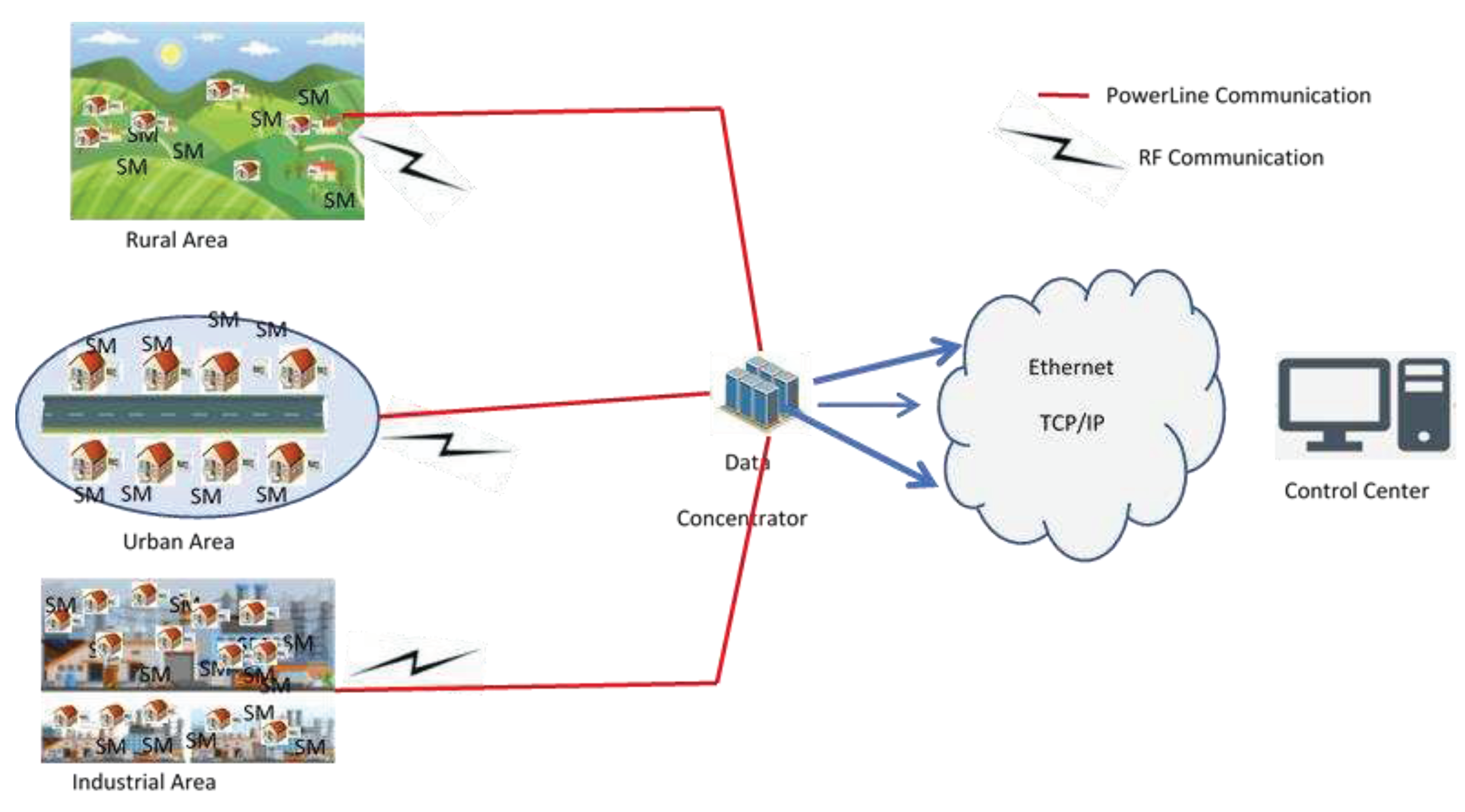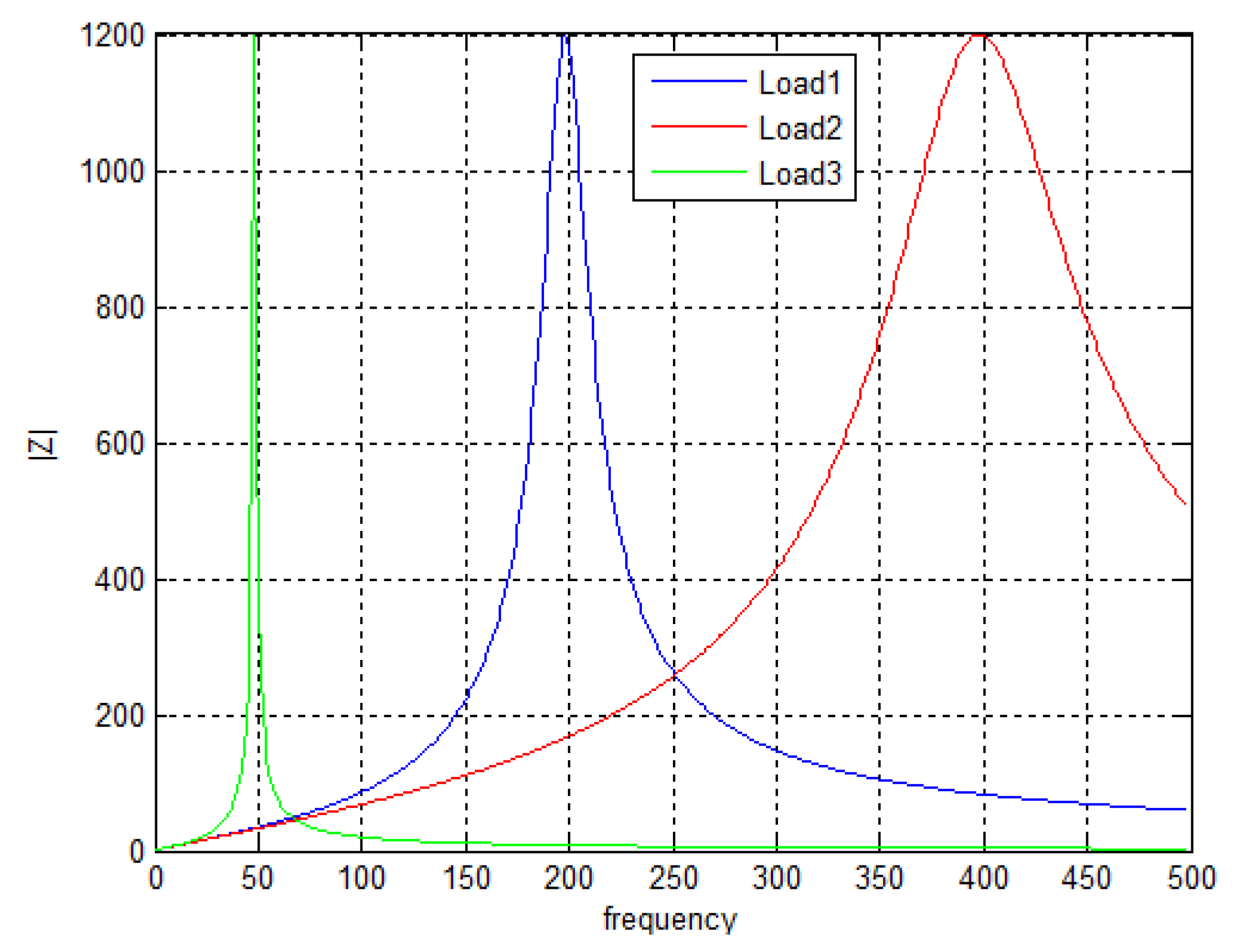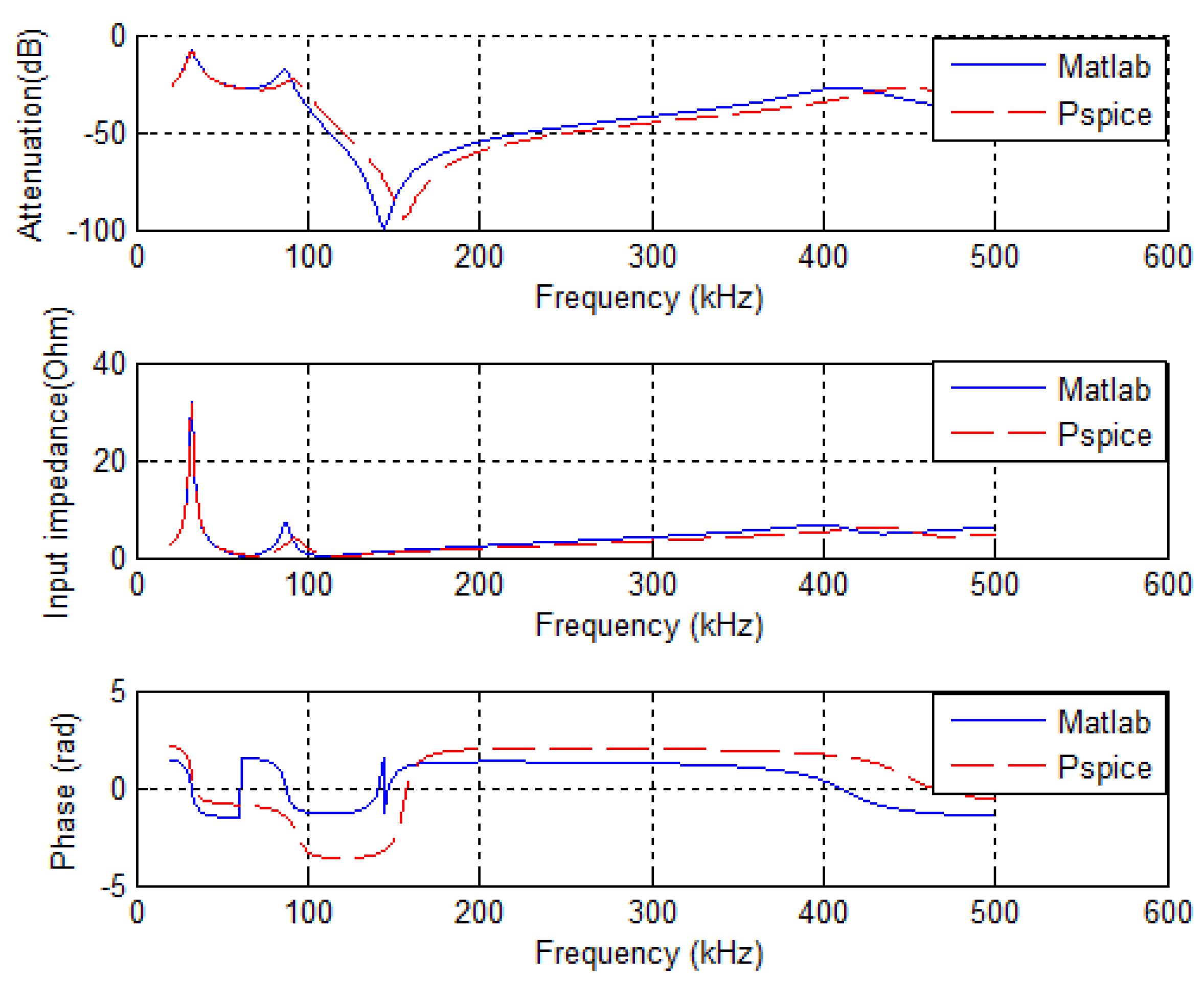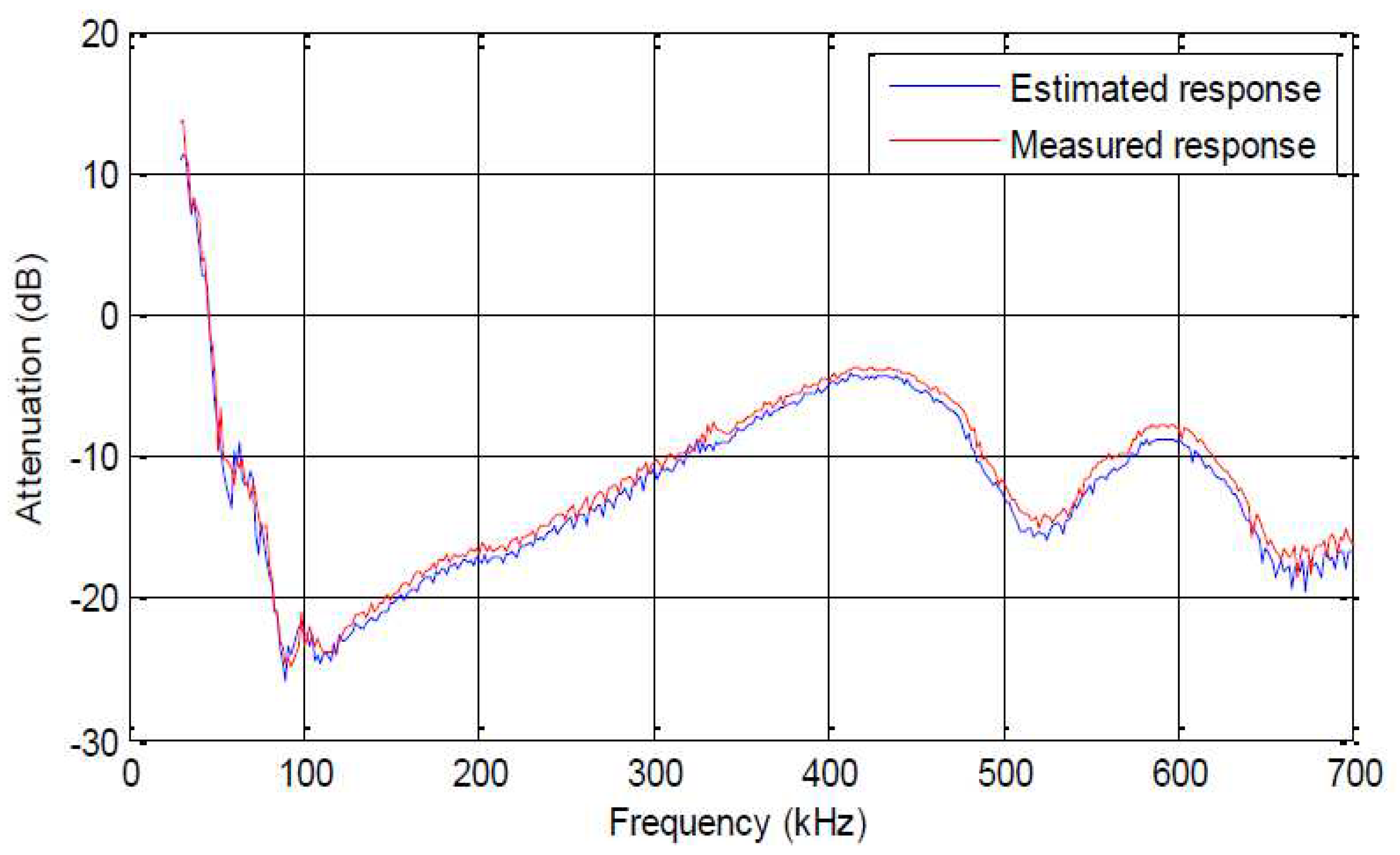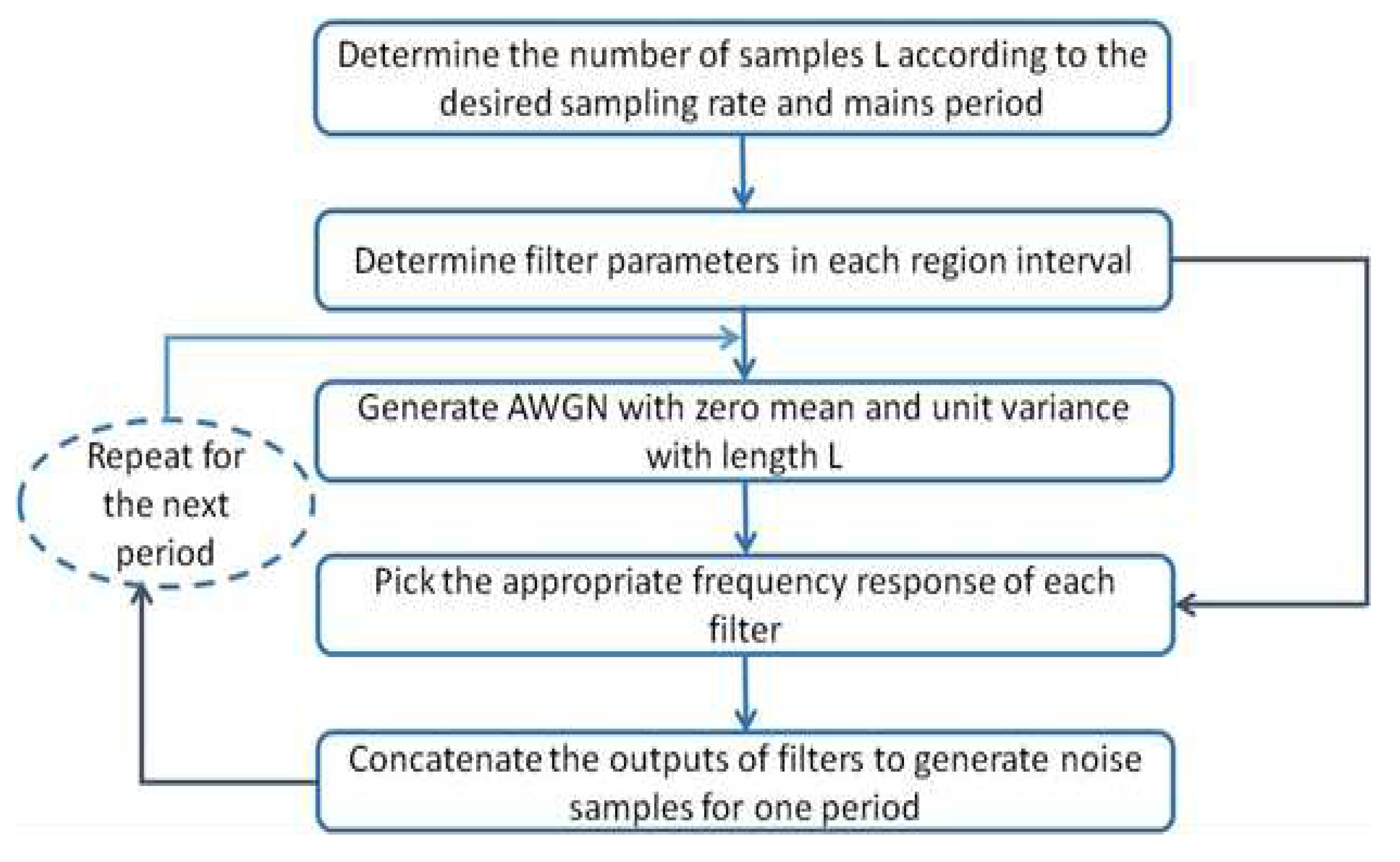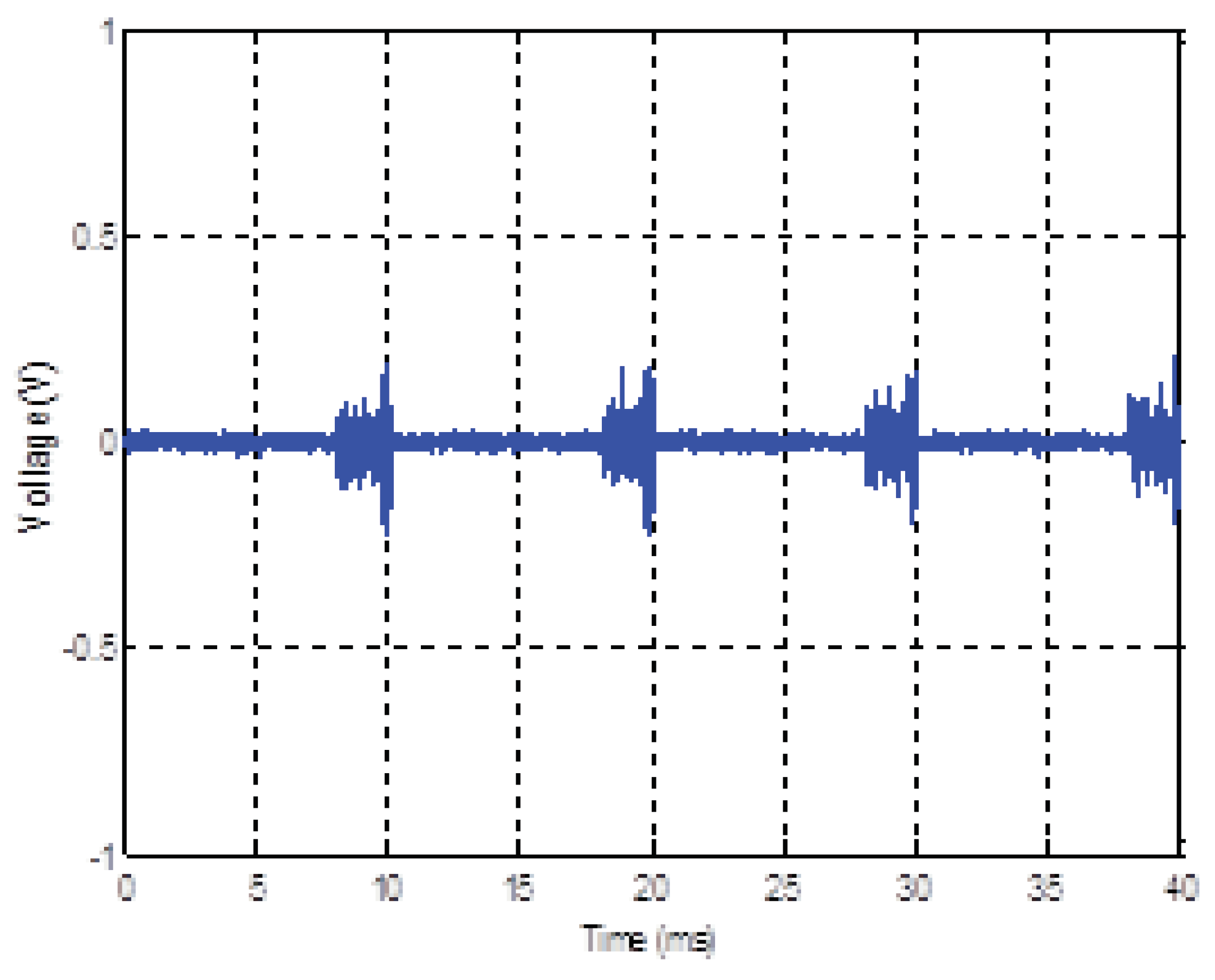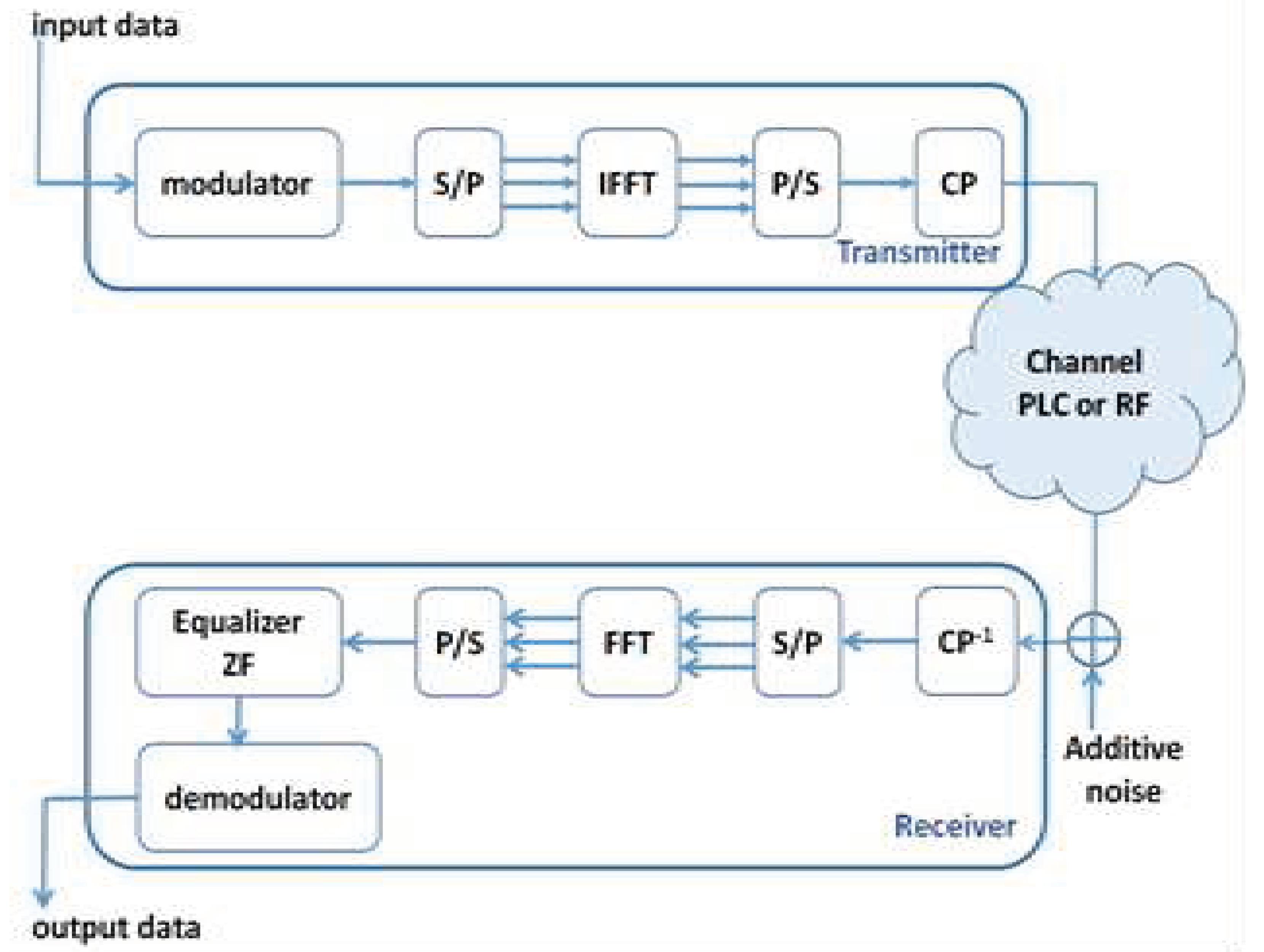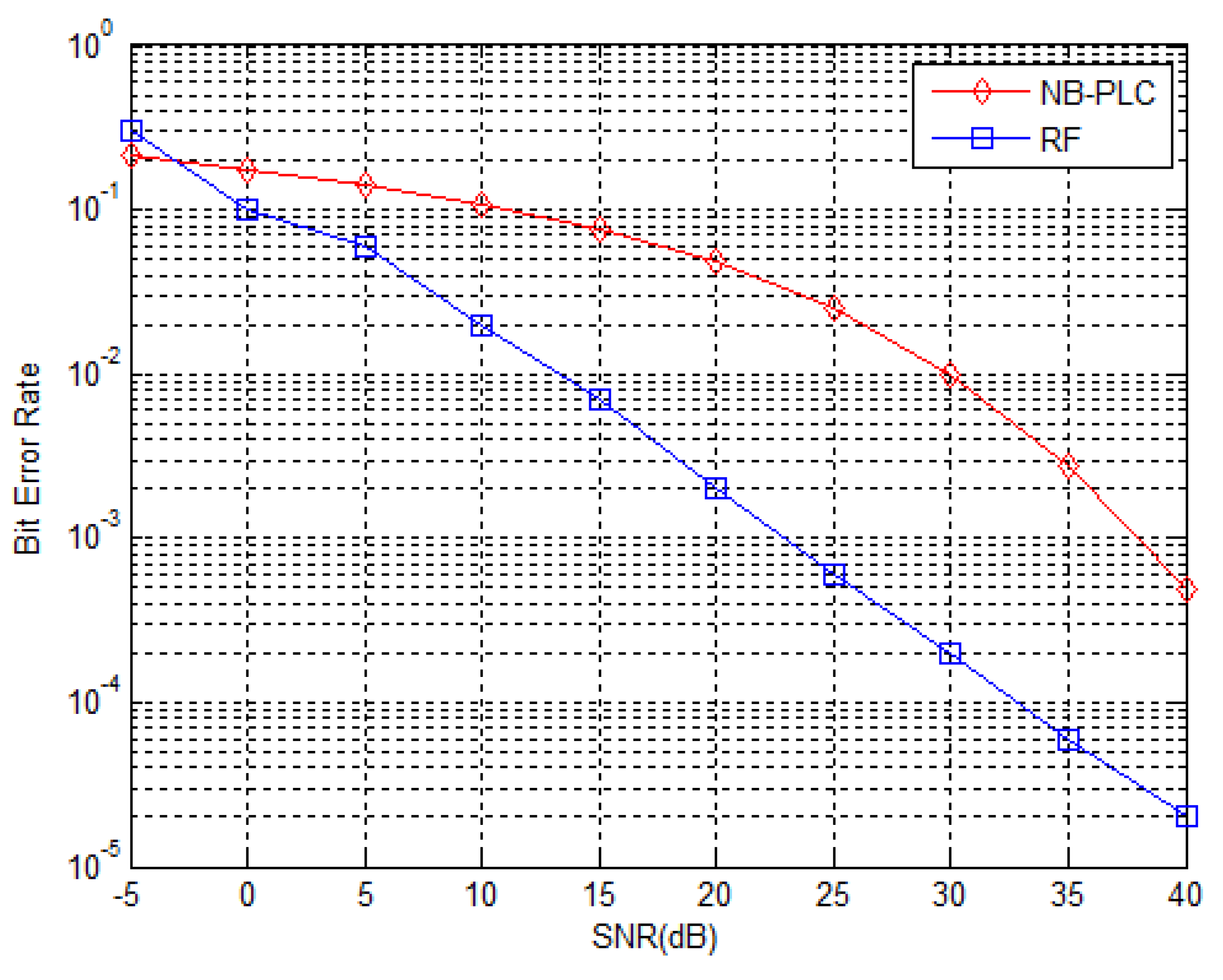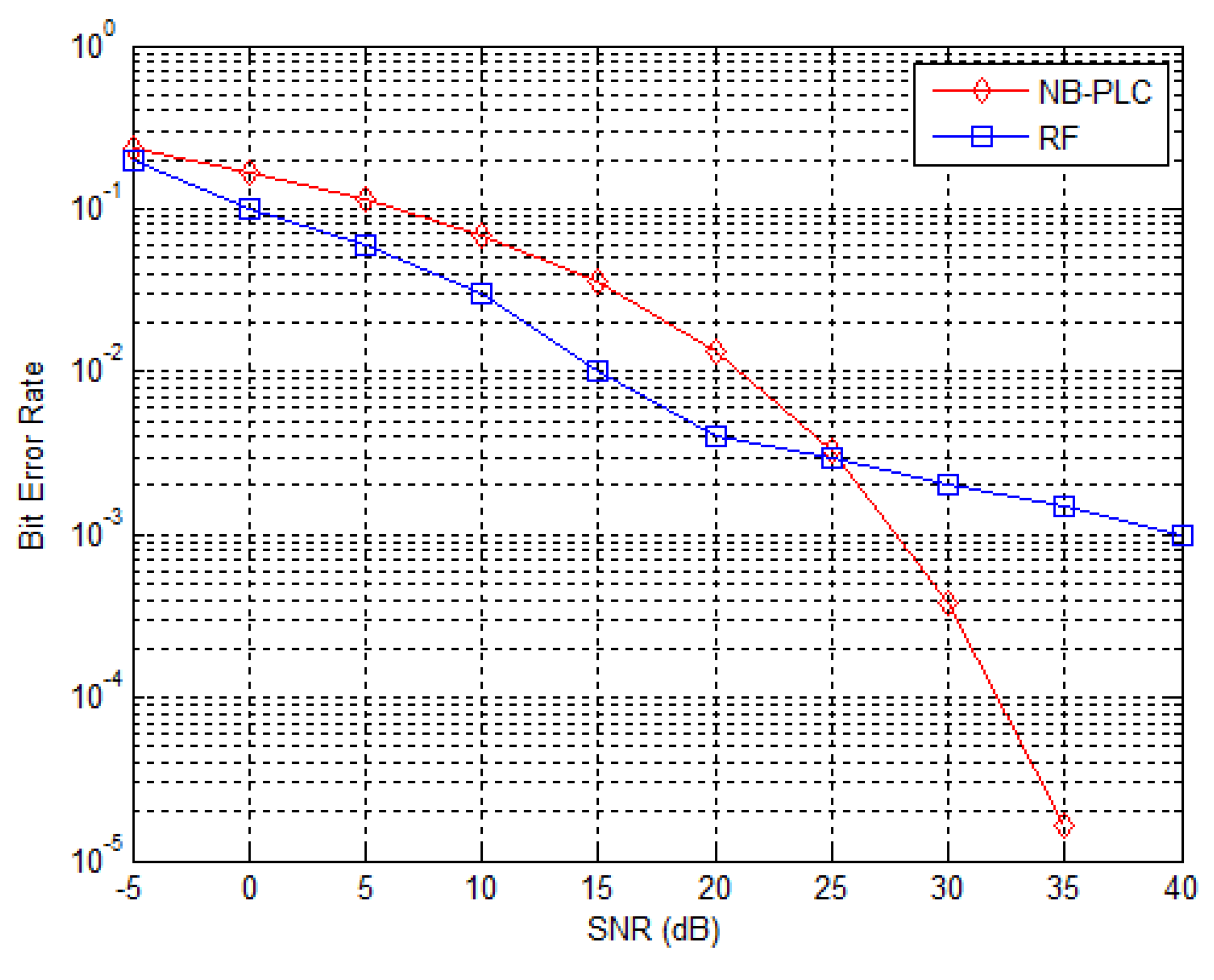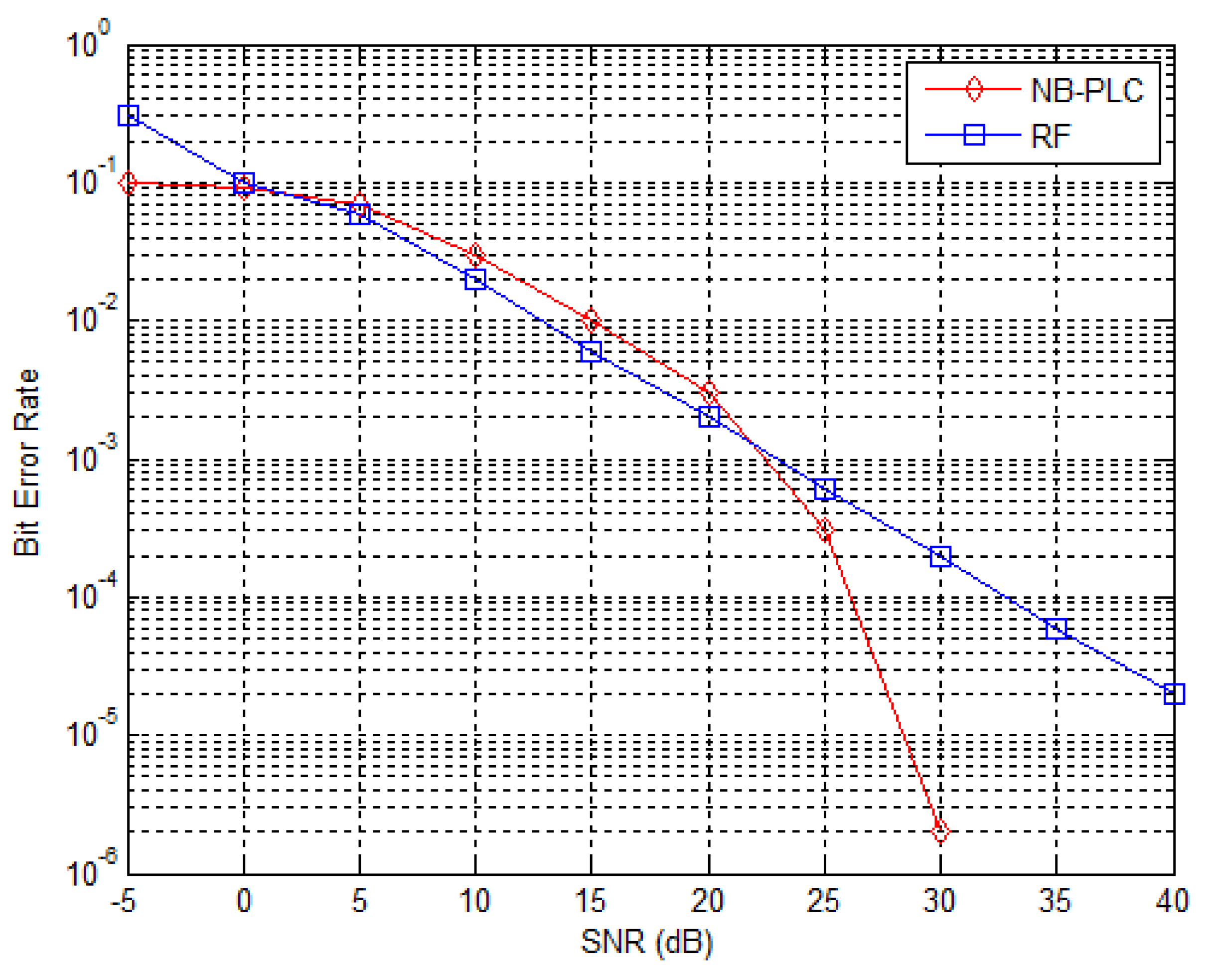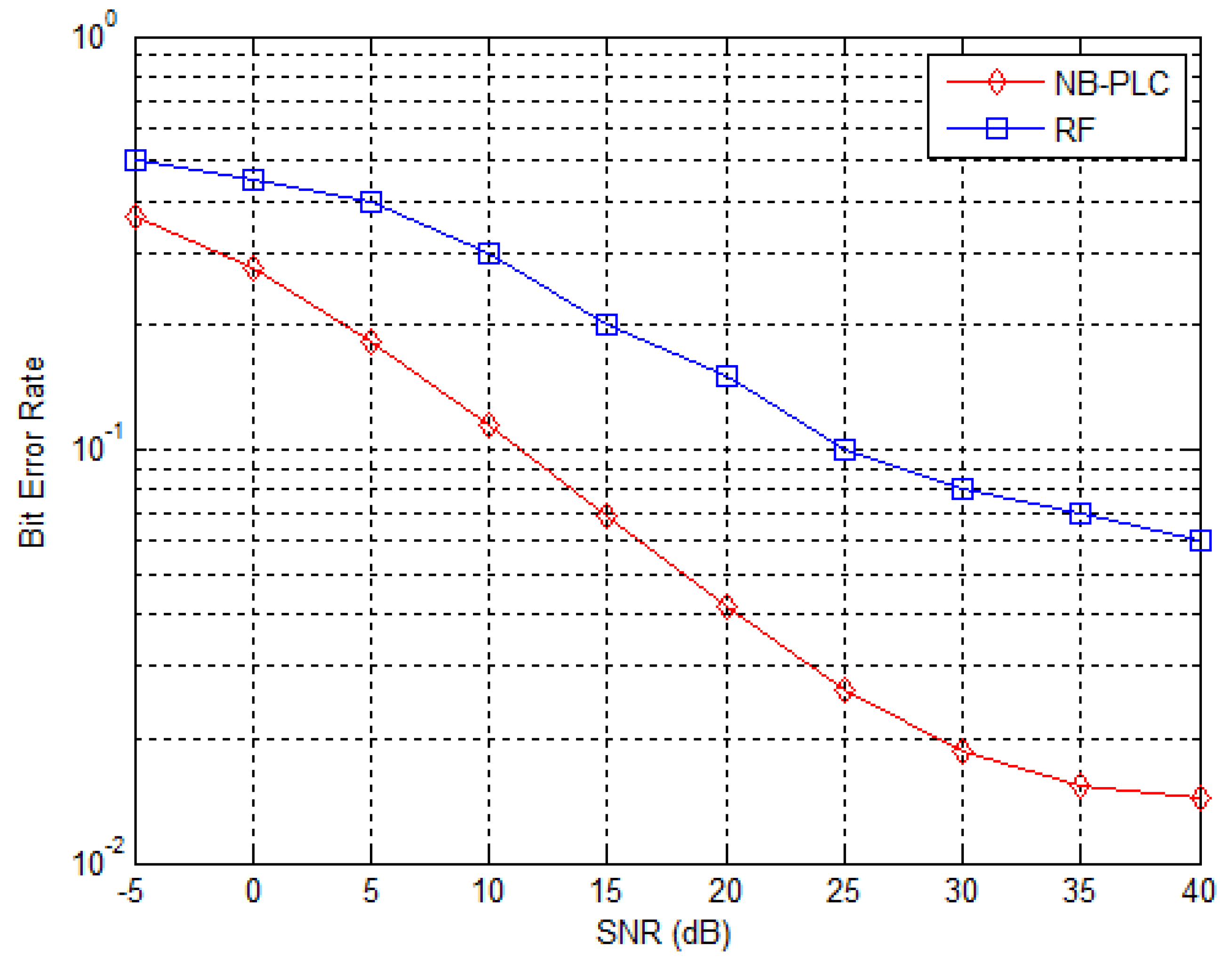1. Introduction
Neural grid represents a hypothetical concept and a theoretical extension of smart grids technologies, incorporating machine learning capabilities and advanced artificial intelligence [
1]. Its main objectives are sustainable energy integration, advanced energy management capabilities for consumers, energy data security and real-time data prediction. To achieve these objectives, it is needed to collect data related to many operations such as production, storage, consumption, distribution and transmission of electricity relying on its communication infrastructure. According to this need, it is necessary to make sure that the communication infrastructure of the smart grid covers a very large geographical area, which may range from distant production sites to overcrowded residential areas, namely buildings and houses.
For smart metering applications, like smart home/building, energy management, grid monitoring and integration of renewable energy sources (RES), several communication technologies can be employed such as NB-PLC, BB-PLC, Zigbee, LTE, UMTS, GSM, WiFi, etc. [
2,
3].
Table 1 gives an overview of the most used and suitable wired and wireless technologies for low-voltage (LV) smart metering applications.
Among the available technologies, wired (NB-PLC) and wireless (RF-Mesh) technologies demonstrate significant promise for efficiently allocating energy resources in smart metering applications. The choice between RF and NB-PLC depends on factors such as coverage requirements, environmental conditions, interference levels, and specific application needs within the smart grid domain. However, despite their cost-effectiveness for Advanced Metering Infrastructure (AMI) applications, NB-PLC and wireless channels present challenges in terms of reliability and overall communication system performances. This paper focuses on investigating the communication between the Data Concentrator (DC) and the Smart Meter (SM) in three selected areas: rural, urban, and industrial. To address this objective, the authors engage in standardization efforts, considering two solutions: (1) incorporating functioning standards into the existing electricity grid with necessary modifications, and (2) developing new communication protocols tailored to the communication requirements of the smart grid.
For wireless link, the two standards, IEEE 802.15.4g [
4] and IEEE 802.11 ah [
5] can be used. In this paper, the authors choose the IEEE 802.15.4g. In fact, the wireless communication standard Wi-SUN (Wireless Smart Utility Network) enables seamless connectivity between smart grid devices and can be implemented with extremely low levels of power consumption compared to other wireless communications. Its physical layer is based on the IEEE 802.15.4g technology operation in 863 MHz - 870 MHz ISM band.
For wired link, several works have been focused on PLC standardization. For narrowband PLC transmissions, the well-known standards are G3-PLC, PRIME [
6], G.hnem [
7] and IEEE 1901.2 [
8]. In [
9], a physical layer standard performance of the three standards, G3, PRIME and IEEE 1901.2, has been compared. In [
10], authors have proposed a new architecture and new devices for Distributed Generation (DG) and Energy Storage System (ESS) management, which makes use of PLC technology. The architecture was developed in the framework of SInERT project, financed by the Italy-Tunisia cross-border cooperation program 2014-2020. The project aims at proposing innovative solutions to integrate renewable energy on the Tunisian electrical grid. In particular, the study included tests on PRIME [
11] and G3-PLC [
12] demonstrating the feasibility of the proposed solution for remote monitoring and control of DG and ESS. In this paper, the authors further investigate the PLC solution and in particular the IEEE 1901.2, which is a revision of G3-PLC operating in the frequency band from 3 kHz to 500 kHz [13-15]. In fact, G3-PLC lowers infrastructure and maintenance costs compared to other wired communications architectures, avoid the need to create new communication paths through obstacles like buildings and can function under impulsive noisy channel conditions.
Additionally, it is necessary to understand the distinct channel characteristics of communication environments as they play a crucial role in determining the performance of any installed communication scheme. Therefore, gaining a comprehensive understanding of these characteristics is essential in order to develop optimal communication solutions and ensure system reliability. This involves selecting the most suitable channel, whether it be PLC or RF, across various topologies such as rural, urban, and industrial settings, as well as different noise profiles.
In this regard, the main objective of this paper is to establish a novel approach for ensuring uninterrupted communication between the smart meter and the concentrator in the Advanced Metering Infrastructure (AMI) system, with a focus on achieving optimal performance in terms of Bit Error Rate (BER) across three distinct environments as illustrated in
Figure 1. The proposed method outlines a dependable communication system that relies on NB-PLC medium when the wireless signal is compromised or weakened due to obstacles or disruptions, and on wireless medium when the PLC signal is negatively impacted by excessive noise or impedance mismatch.
In
Section 2, the authors outline the key characteristics of wireless and narrow-band powerline systems.
Section 3 provides a comprehensive overview of the various environments under consideration: rural, urban, and industrial. In
Section 4, the impact of these environments is analyzed through simulations using both NB-PLC and RF systems. The parameters for each system are set based on the respective standards: IEEE 1901.2 for NB-PLC and IEEE 802.15.4g for RF. The results demonstrate the appropriateness of each link in relation to the specific scenario, taking into account factors such as multipath effects and the type of noise as indicators of channel performance.
2. NB-PLC and RF characterization
RF and NB-PLC technologies are both employed in AMI-NAN systems to facilitate communication among different devices and components. In this section, the authors provide a characterization of each technology specifically in terms of attenuation and noise.
2.1. NB-PLC Characterization
PLC suffers from harsh conditions such as unexpected variations in channel attenuation, multipath effect and uncommon noise characteristics [
16]. A good understanding of its characteristics is of great importance. In this section, the authors overview NB-PLC attenuation and its noise characteristics.
2.1.1. NB-PLC Attenuation
The NB-PLC signals transmitted on power line is affected by high attenuation due to the propagation of line losses which depend on network topology, environmental conditions, and the behavior of connected appliances, exhibiting variable spectro-temporal characteristics [
17]. As a function of loads and network’s layout, PLC may induce high attenuation and deep fading effects. The reproduction of multipath signals is a result of impedance mismatches, which are caused by the presence of many loads connected to the network’s termination points and of multiple cable branches. Therefore, the reflected waves yield to multiple delayed echoes in the channel impulse response. In [
18], the authors investigate narrowband powerline channel modeling and present a bottom-up approach, namely Voltage Ratio Approach (VRA), which is based on the network topology. A comparison of different NB-PLC models is presented in [
19] and demonstrates that the PLC transfer function depends on the network topology and the type of connected loads. In this paper, the authors opt to apply the VRA model as it accurately computes the transfer function. A single branch is defined in
Figure 2a, as the combination of three points: A is the transmitting point (Tx), B is the receiving point (Rx) and C is the connected load which can be another branch. The equivalent representation of a branch in terms of TL (Transmission Line) parameters is depicted in
Figure 2b.
In the representation in
Figure 2b,
l1 denotes the cable length from the Rx end of the path line to the tap point C,
l2 denotes the length of the cable connected from the tap point C to the backbone, and
l3 represents the cable length from the tap point C to the Tx end of the path line A. The input impedances, Z
inB, Z
inC, and Z
in, can be determined using (1) and (2).
Without loss of generality, the authors assume that the direct backbone path (from A to B) consists of the same transmission line, while the stub
ZC is represented by a different line with a defined propagation constant γ
1 and characteristic impedance
Z01. In order to calculate the transfer function of a basic branch, the reflection coefficients of the end path (
Γ1) and from the tap point (
Γ2) are introduced. By applying the Voltage Reflection Algorithm (VRA) method between access point A and end point B, the transfer function H
e(f) is given in (3),
For multibranch network and using (1), the transfer function is written in (4) :
where
N represents the number of branches in the network.
In this paper, the authors suppose that the network between the transmitter and the receiver is a cascade of three single branches where cable’s length depends on the area type : rural, urban or industrial. Loads are frequency selective and modeled by a resonant RLC circuit where its impedance Z(f) is given in (5) :
where R is the resistance, Q is the factor quality that determines selectivity and
is the resonance frequency. Examples of used loads behavior are depicted in
Figure 3.
Based on VRA previously described, a simulating analytic model for industrial area is developed using (3) and implemented in the Matlab tool. This model is then compared to the circuit model in the CAD tool (Pspice) for a three-core cable consisting of phase, neutral, and ground and when the cable type is assumed to be the same for the three branches. The simulation results obtained from both the circuit model (Pspice) and the analytical model (Matlab) are illustrated in
Figure 4.
It can be observed that the curves for attenuation, impedance, and phase exhibit non-smoothed traces. These irregularities arise due to the presence of discontinuities at various frequencies, resulting in the reflection of propagating waves and power loss.
In [
20], a coupling interface has been implemented to build a measurement platform, facilitating a comparison of simulated results. This interface serves two major roles: the first is instrument protection, and the second is the injection/extraction of the test signal to/from the mains. Then, a two-step verification methodology was proposed using the bottom-up approach. Measurements are performed in Lab where many computers are plugged as well as spectrum analyzers. All the measurement setups are connected to the same line phase. The test circuits are constructed using both 1.5mm² and 2.5mm² core cables, with each section spanning a length of 1 meter. The impact of some events on network is shown either by a translation of the channel response magnitude or by the manifestation of pronounced attenuation at distinct frequencies..
Figure 5 shows the concordance between simulated and measured transfer function magnitudes, with an error lower than 3dB.
2.2.2. NB-PLC Noise
According to [21-23], PLC noise may be classified into three types: (1) periodic impulsive noise characterized by its cyclo-stationarity in both time and frequency domain, (2) background noise where its power spectral density (PSD) decreases exponentially and (3) the asynchronous impulsive noise known as random impulses. Since the periodic impulsive noise is the dominant noise component for NB-PLC, authors select it to be the noise model for power line channel. In this paper, following the IEEE 1901.2 standard, linear periodical time-varying (LPTV) system models the periodic impulsive noise [
24]. Given this model, the noise samples are written as in (6),
Where 1
k is the indicator function,
is the impulse response of the LTI filter in the interval
Ri and
vk obeys the Gaussian distribution. The generation of periodic impulsive noise process is summarized in
Figure 6.
In fact, first of all, the authors determine the number of L samples according to the desired sampling rate and mains period. Then, they determine the parameters of each filter corresponding on each region interval. After that, a generation of additive white gaussian noise with zero mean and unit variance of length L is essential to pick the appropriate frequency response of each filter. Finally, the filter’s output are concatenated in order to generate noise samples for one period.
In
Figure 7, the authors present the periodic impulsive noise wave for 4 periods.
As it is clear, this type of noise is characterized essentially by three parameters: number of regions (N
R), region interval (R
j) and the LTI filters parametrized by their corresponding noise PSDs. In
Table 2, the authors summarize the percentage of regions’ intervals.
According to
Table 2, the first region corresponds to the biggest number of OFDM symbols, which means that the duration of the first filter (6.6 ms) used for noise shaping in the AC cycle is the highest compared to the two regions R
2 (1.38 ms) and R
3 (0.26 ms).
2.2. RF Characterization
In smart metering applications, the RF (Radio Frequency) channel model describes the behavior of wireless communication channels between smart meters and data concentrators or other central points within a smart grid system. The channel model provides a mathematical representation of how RF signals propagate, interact with the environment, and experience various impairments and effects during transmission. Understanding and modeling the attenuation and the noise of RF channel is crucial for designing and optimizing communication systems to ensure reliable data transmission and reception in smart metering networks.
2.2.1. RF Attenuation
In this paper, the authors are interested on outdoor environments : rural, urban and industrial, where the wireless signal is subject to several fading phenomena such as reflection, refraction, diffraction, etc. Channel modeling is one of the common challenges for the Wi-SUN mesh network [
25]. This process is primarily employed to predict signal characteristics encompassing channel behaviors like propagation phenomena (including absorption, reflection, scattering, and diffraction), interference sources (involving thermal noise and shared unlicensed frequency bands), and the dynamic nature of the environment (encompassing aspects like multi-path fading channels). By solving Maxwell's equations for all physical elements and environmental factors, the channel model can be obtained, acquiring multi-path fading channels. Consequently, a pragmatic approach involves focusing the channel model on the primary propagation effects, namely reflection, diffraction, and scattering, while disregarding less pertinent details to streamline complexity. These fading phenomena can be categorized into two distinct groups: large-scale fading and small-scale fading. Large-scale fading characterizes the gradual alteration of signals, primarily attributed to the combined effects of path loss and shadowing. Small-scale fading pertains to the swift fluctuations of signals on a smaller scale, driven by three fundamental factors: the signal's delay spread, temporal variations within the channel, and the transmission bandwidth of the channel. For smart metering applications, some of the key components and considerations in an RF channel model include the path loss and multipath propagation.
The path loss, expressed in dB, refers to the attenuation or reduction in the strength of a wireless signal as it propagates through space over a certain distance. It is a critical factor because it directly affects the reach and reliability of wireless communication links between smart meters and data concentrators. The authors in [
26] estimated the connectivity of a smart meter and a data concentrator using a more detailed approach. They employed a path loss model, which includes link-specific terrain profile information to compute diffraction losses. This allows a better estimate of the average link received power for the complete path between each SM and the DC around it. As smart meters are typically deployed across various environments, such as rural, urban and industrial areas. The path loss can vary significantly based on factors like distance, frequency of operation and obstacles. For outdoor environments, its typical values varies from 2.7 to 6.5 depending on the environment characteristics [
27]. In [28-29], researches have demonstrated that the path loss exponent is typically observed to be around 4 for urban areas. In industrial areas, the path loss exponent tends to be around 3, indicating a slightly lower rate of signal attenuation compared to urban areas. On the other hand, flat-lying rural areas generally exhibit even lower values of the path loss exponent. These variations in path loss exponent reflect the different characteristics of each environment and the impact of obstacles, terrain, and other factors on signal propagation
The multipath propagation occurs when signals take multiple paths between the smart meter and the data concentrator, leading to constructive or destructive interference. It emerges from the fusion of signals arriving from diverse directions—a direct path, reflections, diffractions, and scatterings—each accompanied by random amplitudes, phases, and delays. This effect is responsible for fading and can impact signal strength and quality. This intricate interplay underscores the complex nature of wireless communication channel behavior, necessitating well-constructed channel models for accurate analysis and network optimization. The Rayleigh fading model is adopted and it shows the effects of small-scale fading of non-line-of-sight reproduction in wireless communication. A multipath wireless channel can be modelled using the method of the impulse response with the expression (8) [
30]:
where
is the amplitude,
is the phase,
represents the number of paths which depends of t, and
shows the delay.
2.2.2. RF Noise
In addition to the AWGN, in (6), a major design challenge for wireless transmission on unlicensed bands is the presence of strong interference produced primarily by uncoordinated transmissions and neighboring impractical devices on the same frequency band.
Such interference can be characterized by three statistical models of impulsive noise: (1) the stable alpha-symmetric (SαS), (2) the Middleton Class-A (MCA), and (3) the Gaussian Mixture (GM). It should be noted that the symmetric stable alpha unsystematic variable can be similar to the GM model, and the MCA probability density function (PDF) is a special case of the GM PDF. In literature, for the authors’ best knowledge, there is no works presenting noise modeling in the 863-870 MHz wireless frequency band. Assuming the analogy between the sub-1 GHz and the 2.4 GHz band, authors in [
31] model the noise as two-component Gaussian mixture random process and obtain the best distribution that fits the major source of Radio Frequency Interference (RFI) in wireless channel from the RFI Toolbox [
32].
Therefore, the probability density function of the GMM (Gaussian Mixture Model) is computed as a summation of complex Gaussian distributions with zero mean and variance
and given in (9),
where
is the mixing probability and
is the variance of the k
th Gaussian component.
Both RF and NB-PLC technologies have their advantages and considerations, and the choice between them depends on factors such as the specific requirements of the utility company, the geographical characteristics of the area, and regulatory considerations.
3. Environments Characterization
Environment characterization is a critical step in AMI applications, as it ensures that a given communication technology is optimized under specific conditions of the environment, providing reliable and accurate data for smart metering and energy management. Communication between SM and DC covers a very large geographical area where its characteristics affect strongly the transmitted signal for wired and wireless technologies. In fact, dense obstructions such as buildings, floors, walls, etc. or new constructions or tree growth attenuate heavily the wireless signal. However, the PLC signal depends only on the electric network topology and any modification or extension of such network may damage the existing communication. Therefore, to efficiently extend the environment limitation and transmit data to destination through two different communication technologies characteristics, wired and wireless, the authors try to classify areas based on two criteria: density of loads and density of obstructions. This section defines the three environments thus classified, namely rural, urban and industrial.
3.1. Rural Environment
Rural environment can be categorized into low density area. In fact, it refers to an outside area of urban or suburban regions that is primarily characterized by its natural or agricultural landscape. Both wired and wireless communication technologies can be used in rural environments to provide access to communication and information resources. Each technology has its own advantages and limitations. The best choice depend on the specific needs and circumstances of the community.
PLC technology can be a useful technology in rural areas where power lines already exist. It can provide a reliable and cost-effective way to transmit data and communication signals over long distances. However, PLC is limited by the quality and availability of the power lines themselves. In some cases, power lines may be too old or not well-maintained, which can lead to poor signal quality and reduced reliability. Additionally, PLC may be subject to interference from other electrical devices, which can further degrade the quality of the communication signal. The length of the aerial cable, in rural networks, can generally be extended to 1 km when the number of charges is very simple [
33].
RF technology can also be used to provide communication services in rural areas and can be particularly useful in areas where power lines don’t exist or are not reliable. Furthermore, RF can provide high-speed internet access and other communication services to remote and underserved communities, even in areas where traditional infrastructure is lacking. However, wireless technologies can be subject to signal degradation and interference from environmental factors such as weather, terrain, and foliage. These sparsely populated remote areas are less likely to cause distortions which explains the low number of paths.
Overall, the choice between PLC and RF technologies will depend on the specific needs and conditions of the rural environment in question. Careful consideration of factors such as existing infrastructure, signal quality, and reliability will be important in making the best choice for a particular rural environment. A combination of both technologies may also be used to provide a more comprehensive and reliable communication network.
The typical distance between a smart meter and a data concentrator in a rural environment vary depending on various factors, such as the communication technology used, terrain, vegetation, and the presence of any physical obstacles or interference. For PLC system, the distance can range from a few hundred meters to several kilometers, depending on the quality of the power lines and the presence of any electrical devices or interference.
3.2. Urban Environment
Urban environment refers to an area characterized by a high population density, a diversity of used devices, and a concentration of human-built infrastructure and services such as transportation systems, housing, and commercial buildings and cultural institutions. It is often characterized by a high concentration of wired and wireless communication infrastructure, providing residents with a wide range of communication options.
In urban environment, by using the existing power grid, PLC can be used to provide high-speed connectivity without the need for additional infrastructure or cables and can also be used to support specific communication services, such as home automation, smart grid applications, and remote monitoring. However, PLC has some limitations compared to other communication technologies. In fact, the quality and reliability of PLC signal can be affected by noise, electrical interference on the power grid and other factors such as distance, interference from other electrical devices, and the quality of the power grid infrastructure. In addition, PLC may be subject to regulatory and safety requirements related to power grid operations [
34].
RF communication plays a crucial role in enabling smart grid applications in urban environments. In fact, RF technology enables communication between different components of the grid, such as meters, sensors, and control systems. Therefore, they provide a range of services, such as remote meter reading, demand response, and real-time monitoring and control of the grid. For example, AMI uses RF communication to enable two-way communication between smart meters and utility companies, allowing real-time monitoring of electricity usage, besides of remote disconnection and reconnection of service. However, it has several limitations that can affect its reliability and performance. Some of the key limitations include the interference with other wireless devices, buildings and other physical obstacles, signal attenuation due to trees and other objects leading to reduced signal power and range.
Therefore, both RF communication and PLC provides together to provide redundant or complementary communication services and multiple communication paths for smart meter data, ensuring reliable and secure communication even in the presence of interference or other disruptions. In urban environment, smart meters and data concentrators are designed to work within a range of few hundred meters. This range is usually sufficient for most urban environments, where buildings, other structures and electric network topology can often obstruct the transmission of wireless and wired signals.
3.3. Industrial Environment
The industrial environment presents several challenges that can affect the effectiveness and the reliability of communication systems. The AMI applications include the use of various sensors, communication devices, and control systems that enable the monitoring, control, and optimization of energy production, transmission, and consumption. Therefore, the main challenges of AMI applications in the industrial environment are the presence of electromagnetic interference (EMI) which can be caused by various sources, such as electrical motors, welding equipment, and the need for reliable and secure communication which should be designed to provide access control to ensure data confidentiality and integrity.
In AMI applications, in the one hand, PLC technology enables communication between smart meters and the concentrator in order to collect accurate and real-time energy consumption data. However, it can face challenges due to electrical noise, interference from other devices, and varying signal strengths caused by the different lengths and quality of power lines [35-36]. In the other hand, RF technology enables wireless communication between smart meters and the concentrator without the need for physical connections or cables, reducing the cost and complexity of installation and over longer distances, making it ideal for large industrial facilities or remote locations. However, it faces challenges in industrial environments, such as signal interference from other devices, multi-path signal propagation, and attenuation due to obstacles such as walls and metal structures signal [37-38].
Overall, the specific choice of communication technology for AMI applications depends on several factors such as the specific requirements of the industrial environment, the availability of power lines, the overall cost and performance of the communication system. In this case, the range between SM and DC can be reduced by the presence of machinery, equipment, or other structures that can obstruct the transmission of wireless signals. In general, in an industrial environment, the distance is likely to be less than in a urban environment, and may require more sophisticated communication technologies to ensure reliable and efficient communication.
To ensure a reliable link between the smart meter (SM) and the data concentrator (DC) in a well-defined area, the choice of communication technology, either RF or NB-PLC, should be based on several parameters. These parameters can be set to evaluate and compare the performance of each technology.
4. Simulation Results
This section deals with a simulation model of the OFDM communication chain as described in
Figure 9 over wireless (RF) and wired (NB-PLC) links for rural, urban and industrial environments. As depicted in
Figure 9, data is processed using the IFFT algorithm, which converts the time-domain signals into frequency-domain signals. This operation splits the signal into multiple subcarriers which are assigned specific data symbols. According to the selected standards, pilot symbols are inserted for channel estimation and equalization purposes. Furthermore, when transmitting data between a smart meter and data concentrator, an appropriate modulation scheme is crucial. The choice of modulation directly impacts the efficiency and reliability of data transmission. At the receiver side, a Zero Forcing (ZF) equalizer is used in order to mitigate the effects of channel distortion and interference. The performances of simulated OFDM communication chain are evaluated by computing the Bit Error Rate (BER) for each value of Signal to Noise Ratio (SNR). It reflects the accuracy of data transmission, representing the ratio of erroneous bits to the total transmitted bits. All simulations are implemented on Matlab tools.
4.1. Simulation parameters
To establish communication between smart meters and the data concentrator, the authors opt to use the Wi-SUN standard for RF-based communication and the IEEE 1901.2 standard for NB-PLC communication. These standards provide the necessary specifications and guidelines for implementing the communication protocols in AMI systems, ensuring compatibility and reliable data exchange between smart meters and the data concentrator.
For NB-PLC, according to IEEE 1901.2 standard, the OFDM symbol contains a 256-point IFFT adjoined by cyclic prefix (CP) corresponding to 30 samples. These samples are used to remove the Inter-symbol interference (ISI) which is created by channel effect. For RF, parameters are selected by the authors according to the IEEE 802.15.4g MR-OFDM standard (option2). They assume that one symbol OFDM is of size 64 subchannels and a cyclic prefix of 16 symbols.
As the OFDM signal is transmitted through the RF or NB-PLC channel, it encounters reflections, delays, and attenuation due to the varying characteristics of the communication environment. To mitigate the effects of multipath fading, channel distortion, and inter-symbol interference, Zero Forcing equalizer is implemented in the OFDM system.
The noise models used for wired or wireless communication channels include AWGN, Cyclostationary impulsive noise, and Gaussian Mixture impulsive noise (GMM). The specific selection of the noise model for each channel and each area is outlined in
Table 3.
The parameter characteristics of each environment, rural, urban, and industrial, have a significant impact on the design and performance of a smart metering system. In this paper, the key parameters of each environment are (1) the path number for wireless link, (2) the line length for the wired link and (3) the noise model for each link.
In rural environment, the smart metering system is typically designed to cover larger areas and longer distances between devices. This may require the use of higher-power communication technologies, such as PLC or RF, to ensure reliable communication over longer distances. In this paper, the authors use 1 km as a distance between the SM and the DC. For RF communication system, the distance can also vary depending on factors such as the presence of physical obstacles. This variation is modeled by the channel path number. Therefore, the authors choose the electrical line length greater than 200 m and the path number is equal to 5 with Additive White Gaussian Noise.
In urban environment, the smart metering system is typically designed to handle a larger number of connected devices compared to rural environment. The system is designed to operate over short distances and with higher-power communication technologies, NB-PLC or RF, due to the higher density of devices and potential for interference. In this paper, the authors use 200 meters, the distance between the SM and the DC. For NB-PLC, the authors choose the electrical line length between 30 and 50 meters with Cyclostationary impulsive noise. For RF, the path number is between 10 and 20 with GMM and/or AWGN noises.
In industrial environment, the smart metering system is typically designed to handle also a large number of devices with complex and noisy environments. To ensure reliable communication, the electrical line length is less than 15 meters and the noise is cylostationary noise for NB-PLC. The path number of RF link is greater than 40 and the noise is modeled as GMM as given in (9).
In this paper, the authors choose a topology network with 3 branches as shown in
Figure 8 where AB, BC, CD and DH are the lines of the electrical network whereas E, F and G are the connected loads which their behaviors are depicted in
Figure 3.
The authors summarize in
Table 3 the characteristic parameters of each communication link, RF and NB-PLC, for the three environments described above.
4.2. Rural Environment
Figure 10 illustrates the performance of the communication chain using RF and NB-PLC links in a rural environment. The simulation parameters for this scenario are summarized in
Table 3. In this specific case, the distance between the smart meter (SM) and the data concentrator (DC) is set to 1 km. For the NB-PLC link, the electric line is divided into three branches, as depicted in
Figure 8. Each branch of the NB-PLC line has a length of 200 meters. In the simulation setup, the RF path number is configured to be 5, indicating the presence of multiple RF paths. The noise model utilized for both RF and NB-PLC links is additive white Gaussian noise (AWGN), a commonly used noise model in communication systems.
Figure 10 demonstrates that the RF link outperforms the NB-PLC link in terms of performance. This can be attributed to the rural environment being characterized by a low number of obstructions. With a Bit Error Rate (BER) equal to 10
-3, the RF link exhibits higher performance compared to the NB-PLC link, with a difference of approximately 15 dB. Therefore, transmitting data over the RF link is suitable for the rural environment.
In order to provide extensive network coverage for nodes situated at greater distances, multi-hop operations are likely to be employed in rural areas, where the population is sparse and the number of obstructions is low. Considering this scenario, the RF technology emerges as a suitable communication solution for facilitating information exchange between SM and DC within this environment.
4.3. Urban Environment
The authors simulate the performance of both links in urban environment for two scenarios. In the first scenario, the RF path number is equal to 20 with AWGN noise and the NB-PLC line length is set to 20 meters and the noise is cyclostationary impulsive noise.
The curves depicted in
Figure 11 illustrate that, for small Signal-to-Noise Ratio (SNR) values (less than 25 dB), the RF link outperforms the NB-PLC link. There is an approximate 7 dB gap observed for a Bit Error Rate (BER) of 10-2. This indicates that despite the environmental density, the wireless link surpasses the wired link, confirming that the electrical network topologies within buildings significantly attenuate the signal transmitted between SM and DC.
On the other hand, for high SNR values (greater than 25 dB), the performance of the NB-PLC link surpasses that of the RF link, with an approximate 13 dB gap observed for a BER of 10-3. These results demonstrate that despite the low level of noise, the BER of the wireless link does not decrease considerably.
To investigate the impact of the path number for the RF channel and the line length for the PLC channel on the performance of the communication chain, the second scenario is considered, representing an urban area characterized by moderate congestion and noise. In this scenario, the authors decrease the path number parameter from 20 to 10 and increase the line length from 20 meters to 50 meters.
The curves indicate that for SNR values less than 25 dB, the BER performances are similar for both environments. However, for SNR values greater than 25 dB, it is more suitable to utilize the PLC link. These findings highlight that buildings in urban areas attenuate the RF signal, despite the complexity of the electrical network.
Compared to the rural area, it can be observed that an increase in the number of paths and the complexity of the topology impact the transmission performance of the channel in urban areas.
4.4. Industrial Environment
In order to supervise physical equipment, the industrial network represents the most suitable system since it works on studying different interlinked equipment.
Figure 13 shows the performance of RF and NB-PLC in terms of bit error rate under an industrial environment. For RF link, the path number is equal to 40 and the noise is GMM using (9) where π
1=0.99, π
2=0.01,
=0.001 and
=100. For NB-PLC link, the length line is equal to 10 m and the noise is cyclostationary impulsive.
The authors demonstrate that, despite the high connection density, presence of light-ing loads, non-linear loads, and various distribution types in the industrial area; the NB-PLC is more performant than the RF link. In fact, NB-PLC systems are designed to handle and mitigate such noise, ensuring reliable and robust communication even in the presence of these disturbances. Furthermore, NB-PLC signals can penetrate through various obstacles and materials commonly found in industrial areas, such as walls, metal structures, or machinery. This allows for better signal propagation and coverage compared to RF.
4.5. Discussion
Based on the simulation results, the authors note these findings :
- -
Rural Environment: Simulation results suggest that RF link demonstrates better performance in rural areas. Since they typically have lower population density and less electromagnetic interference, the use of RF link can be more feasible and provide reliable communication with better performance. By the way, PLC can be a valid option even in low density rural areas if repeater can be installed. In this viewpoint the choose of the protocol is crucial. G3 or PRIME protocol has mechanism to promote simple nodes to relay nodes and automatically build the network. This kind of protocols can be exploited in order to get a strong interconnected and reliable PLC network.
- -
Urban Environment: The choice between RF link and NB-PLC for communication between SM and DC in AMI system depends on the density of the area.
For high-density urban environments and low Signal-to-Noise Ratio (SNR) value, lower than 25 dB, it suggests that RF link is suitable. This is likely due to the presence of numerous non-linear loads in close proximity, which can make NB-PLC communication more challenging due to potential signal interference. However, for high Signal-to-Noise Ratio (SNR) value, higher than 25 dB, NB-PLC is indicated to provide robust and reliable communication between the SM and DC as it takes advantage of the existing power lines and their inherent shielding properties.
For moderate density urban environments, both NB-PLC and RF can be suitable choices for communication between the SM and DC. The decision between them in this scenario depends on other factors such as infrastructure availability, cost considerations, and specific application requirements. However, NB-PLC is a suitable choice for high SNR value, greater than 25 dB, where the noise and interference levels are relatively low.
- -
Industrial Environment: Simulation results indicate that NB-PLC is suitable for industrial areas, likely due to the advantages mentioned earlier, such as the presence of abundant power lines, signal penetration, interference immunity, and noise rejection.
5. Conclusion
This paper analyzes the impact of different environment types, rural, urban, and industrial on NB-PLC and RF communication technologies applied between SM and DC in the Advanced Metering Infrastructure (AMI). Based on their findings, the authors propose optimal communication solutions and highlight the advantages of using specific technologies in each environment type. Obtained results show that in rural environments, RF link are suitable for transmitting data. The lower population density and reduced electromagnetic interference in rural areas make wireless communication a feasible and reliable option. However, in dense urban areas with obstructions, the study recommends using power line communication (NB-PLC) when the noise level is low. NB-PLC utilizes existing power lines, providing a reliable communication link in urban environments with fewer obstacles. Finally, for industrial areas, the authors identify NB-PLC as the preferred choice for communication between the DC and SM. The inherent advantages of NB-PLC, such as signal penetration through obstacles, noise immunity, and the availability of power lines, make it more performant than RF links in industrial settings.
The aim of this paper is to propose a model that can be adapted to the real world based on the actual structure of the network. This model aims to understand the extent of attenuation and make informed decisions regarding the implementation of the infrastructure.
In order to enhance system reliability and overcome limitations, the paper suggests implementing a hybrid system that combines both NB-PLC and RF technologies. By utilizing the best aspects of each technology, a hybrid approach can optimize the communication link and ensure the lowest attenuated transmitted signal, resulting in improved overall performance.
Author Contributions
Conceptualization, O.B.; methodology, O.B. and C.R.; software, O.B.; validation, O.B., M.B.R., G.A., and C.R.; formal analysis, O.B., N.P., D.D.C.; investigation, O.B. and C.R.; resources, O.B.; data curation, O.B. and M.B.R.; writing—original draft preparation, O.B.; writing—review and editing, O.B., C.R., M.B.R., G.A., N.P., D.D.C.; visualization, O.B., N.P.; supervision, C.R.; project administration, C.R., M.B.R.; funding acquisition, C.R., D.D.C.. All authors have read and agreed to the published version of the manuscript.
Funding
This work was financially supported by the European Union (EU) within the context of ENI Cross-Border Cooperation Italy-Tunisia Programme 2014-2020 as part of the Project n. IS_2.1_131, Project title: “Solutions innovantes pour l’intégration des énergies renouvelables sur le réseau électrique tunisien”, Project acronym: SInERT, CUP: B74I19001040006 and B74I18014130002. The paper content is responsibility of the authors and it does not necessarily reflect the point of view of the European Union or that of the Program Managing Authority.
Institutional Review Board Statement
Not applicable.
Informed Consent Statement
Not applicable.
Data Availability Statement
Not applicable.
Acknowledgments
The authors wish to thank STEG (Société Tunisienne de l’Electricité et du Gaz), SOPES (Ustica desalination plant management company) and D’Anna e Bonaccorsi (Ustica electrical DSO) associated partners of SInERT project.
Conflicts of Interest
The authors declare no conflict of interest.
References
- Aguiar-Pérez, J.; Pérez-Juarez, M. An Insight of Deep Learning Based Demand Forecasting in Smart Grids. Sensors 2023, 23(3), 1467. [CrossRef]
- Andreadou, N.; Guardiola, M.; Fulli, G. Telecommunication Technologies for Smart Grid Projects with Focus on Smart Metering Applications. Energies 2016, 9, 375. [CrossRef]
- Maalej, A.; Ben-Romdhane, M.; Rebai, C.; Ghazel, A.; Desgreys, P.; Loumeau, P. Toward Time-Quantized Pseudorandom Sampling for Green Communication. IEEE Transactions on Circuits and Systems II: Express Briefs. Vol. 61, Issue: 6, 2014. [CrossRef]
- IEEE Standard for Local and Metropolitan Area Networks–Part 15.4: Low-Rate Wireless Personal Area Networks (LR-WPANs) Amendment 3: Physical Layer (PHY) Specifications for Low-Data-Rate, Wireless, Smart Metering Utility Networks. IEEE Std 802.15.4g-2012 (Amendment to IEEE Std 802.15.4-2011), 2012, 1–252. [CrossRef]
- Khorov, E.; Lyakhov, A.; Krotov, A.; Guschin, A. A survey on IEEE 802.11ah: An enabling networking technology for smart cities. Computer Communications, 2015, 58, 53-69.
- Berganza, I.; Sendin, A.; Arriola, J. PRIME : Powerline Intelligent Metering Evolution. CIRED Seminar 2008 : SmartGrids for Distribution, 2008, 1–3. [CrossRef]
- Oksman, V.; Zhang, J. G.HNEM : the new ITU-T standard on narrowband PLC technology. IEEE Communications Magazine, 2011, 49, 36–44. [CrossRef]
- IEEE Standard for Low-Frequency (less than 500 kHz) Narrowband Power Line Communications for Smart Grid Applications. IEEE Std 1901.2-2013, 1-269. [CrossRef]
- Upadhyay, A.; Gupta, A.; Kumar, V. Comparative study of narrowband PLCs physical layer under AWGN and narrowband interferer. Annual IEEE India Conference (INDICON), 2015, 1–4. [CrossRef]
- Artale, G.; Maalej, A.; Ben Rhouma, O.; Ben-Romdhane, M.; Ben Othman, N.; Cataliotti, A.; Cosentino, V.; Culcasi, A.; Fiorino, M.; Guaiana, S.; Panzavecchia, N.; Tinè, G.; Di Cara, D.; “Innovative solutions for the integration of renewable energies on Tunisian and Sicilian electrical grids," IEEE BLORIN 2022 - 1st Workshop on BLOckchain for Renewables Integration - 2-3 September, 2022, Palermo, Italy.
- Artale, G.; Caravello, G.; Cataliotti, A.; Cosentino, V.; Ditta, V.; Di Cara, D., Guaiana, S.; Panzavecchia, N.; Tinè, G.; A PLC based monitoring and remote control architecture for Distributed Generation and Storage systems in LV smart grids, IEEE Forum on Research and Technologies for Society and Industry - IEEE RTSI 2021, 6–9 Sept. 2021, Naples, Italy, On line conference. [CrossRef]
- Artale, G.; Caravello, G.; Cataliotti, A.; Cosentino, V.; Di Cara, D., Fiorelli, R.; Guaiana, S.; Panzavecchia, N.; Tinè, G.; "A Line Impedance Calculator Based on a G3 PLC Modem Platform," in IEEE Transactions on Instrumentation and Measurement, vol. 71, pp. 1-10, 2022, Art no. 5500610. [CrossRef]
- Usman, A.; Shami, S.H. Evolution of Communication Technologies for Smart Grid applications. Renewable and Sustainable Energy Reviews. 2013, 19, 191–199. [CrossRef]
- Razazian, K.; Umari, M.; Kamalizad, A.; Loginov, A.; Navid, M. G3-PLC specification for powerline communication : Overview, system simulation and field trial results. ISPLC, 2010, 313–318. [CrossRef]
- Lavenu, C.; Chauvenet, C.; Treffiletti, P.; Varesio, M. Hueske, K. Standardization Challenges, Opportunities and Recent Evolutions for the G3-PLC Technology. MDPI Energy, 2021, 14(7), 1937. [CrossRef]
- Ferreira, H.; Lampe, L.; Newbury, J.; Swart, TG. Power Line Communications: Theory and Applications for Narrowband and Broadband Communications over Power Lines. Wiley, 2011.
- El Sayed, W.; Lezynski, P.; Smolenski, R.; Madi, A.; Pazera, M.; Kempski, A. Deterministic vs. Random Modulated Interference on G3 Power Line Communication. MDPI Energies, 2021, 14(11), 3257. [CrossRef]
- Souissi, S.; BenRhouma, O.; Rebai, C. Bottom-up approach for narrowband powerline channel modeling. IEEE Global Communications Conference (GLOBECOM), 2013, 2987–2992. [CrossRef]
- Aloui, A.; BenRhouma, O.; Rebai, C. Comparison of different channel modeling techniques used in NB-PLC systems. International Conference on Advanced Systems and Electric Technologies(IC_ASET), 2018, 125–131. [CrossRef]
- Souissi, S.; Benrhouma, O; Rebai, C. Design of coupling interface for narrowband Power Line Communication channel characterization. International Symposium and18th International Workshop on ADC Modelling and Testing, Research on Electric and Electronic Measurement for the Economic, 2014.
- Zhiru, G.; Hongli, L.; Dawei, L.; Ka-Lok, M.; Haining, L.; Zhouwen, T. Modeling the Noise in NarrowBand Power Line Communication. International Journal of Control and Automation, 2016, 9, 41-48.
- Nieman, K.F.; Lin, J.; Nassar, M.; Waheed, K.; Evans, B.L. Cyclic spectral analysis of power line noise in the 3–200 kHz band. IEEE 17th International Symposium on Power Line Communications and Its Applications, 2013, 315–320. [CrossRef]
- Nassar, M.; Dabak, A.; Kim, I.H.; Pande, T.; Evans, B.L. Cyclostationary noise modeling in narrowband powerline communication for Smart Grid applications. IEEE International Conference on Acoustics, Speech and Signal Processing (ICASSP), 2012, 3089–3092. [CrossRef]
- Da Rocha Farias, L.; Monteiro, L.F.; Leme, M.O.; Stevan, S.L. Empirical Analysis of the Communication in Industrial Environment Based on G3-Power Line Communication and Influences from Electrical Grid. MDPI Electronics, 2018, 7, 194. [CrossRef]
- Tangsunantham, N.; Pirak, C. Experimental Performance Analysis of Wi-SUN Channel Modelling Applied to Smart Grid Applications. Energies 2022, 15(7), 2417. [CrossRef]
- Mochinski, M-A.; Vieira, M.; Biczkowski, M.; Chueir, I.; Jamhour, E.; Zambenedetti, V.; Pellenz, M.; Enembreck, F. Towards an Efficient Method for Large-Scale Wi-SUN-Enabled AMI Network Planning. Sensors 2022, 22(23), 9105. [CrossRef]
- Goldsmith, A. Wireless Communications. Cambridge University Press, 2005, 43-50.
- M.1225 : Guidelines for Evaluation of Radio Transmission Technologies for IMT-2000. Available online : https://www.itu.int/dms_pubrec/itu-r/rec/m/R-REC-M.1225-0-199702-I!!PDF-E.pdf (Accessed on 20 October 2021).
- Baidya, B.; Sen, S. Qualitative analysis on Log-Distance propagation for Wlan standard. Indian Journal of Research, 2014, 3, 96-70.
- Simon, M.K.; Alouini, M.S. Digital communication over fading channels. John Wiley & Sons, 2005, 18-23.
- Nassar, M. Graphical models and message passing receivers for interference limited communication systems. PhD dissertation, The University of Texas at Austin, 17 April 2013.
- Austin Interference Modeling and Mitigation Toolbox. Available online : https://users.ece.utexas.edu/~bevans/projects/rfi/software/ (Accessed on 25 October 2021).
- Elfeki, I.; Jacques, S.; Aouichak, I.; Doligez, T.; Raingeaud, Y.; Bunetel, J. Characterization of Narrowband Noise and Channel Capacity for Powerline Communication in France. MDPI Energies Journal, 2018, 11, 3022.
- Prasad, G.; Huo, Y.; Lampe, L.; Leung, V.C.M. Electromagnetic compatibility of power line communications in energy storage units. IEEE International Symposium on Power Line Communications and its applications (ISPLC), 2018, 1-6. [CrossRef]
- Liu, W.; Sigle, M.; Dostert, K. Channel characterization and system verification for narrowband power line communication in smart grid applications. IEEE Communications Magazine, 49, 2011, 28–35. [CrossRef]
- Wonnacott, R.; Ching, D.; Chilleri, J.; Safta, C.; Rashkin, L.; Reichardt, T. Industrial PLC Network Modeling and Parameter Identification Using Sensitivity Analysis and Mean Field Variational Inference. Sensors 2023, 23(5), 2416. [CrossRef]
- Sheikh, AA. Feasibility of NB-PLC in LT power distribution network of electric utility in Pakistan. Clemson University Power Systems Conference (PSC), 2016, 1–7. [CrossRef]
- Galli, S.; Scaglione, A.; Wang, Z. For the Grid and Through the Grid: The Role of Power Line Communications in the Smart Grid. Proceedings of the IEEE, 2011, 99, 998–1027. [CrossRef]
|
Disclaimer/Publisher’s Note: The statements, opinions and data contained in all publications are solely those of the individual author(s) and contributor(s) and not of MDPI and/or the editor(s). MDPI and/or the editor(s) disclaim responsibility for any injury to people or property resulting from any ideas, methods, instructions or products referred to in the content. |
© 2023 by the authors. Licensee MDPI, Basel, Switzerland. This article is an open access article distributed under the terms and conditions of the Creative Commons Attribution (CC BY) license (http://creativecommons.org/licenses/by/4.0/).
